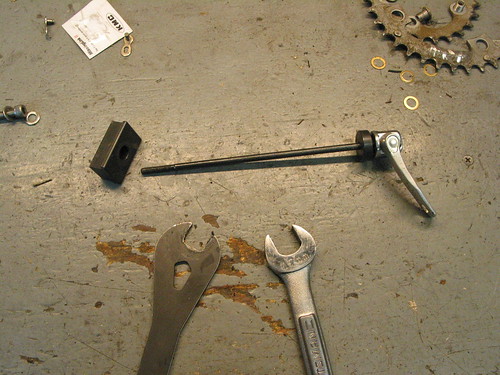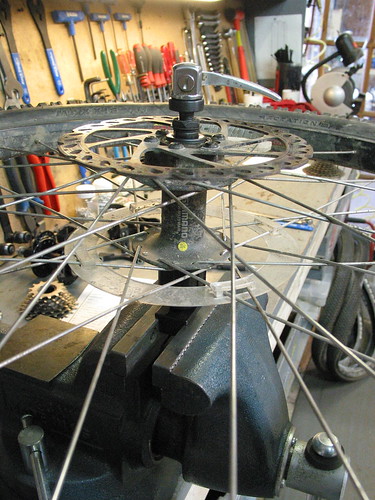By blackmountaincycles,
Filed under: Uncategorized
A comment yesterday on the quick release post got me to revisit another subject I had been meaning to write about. What had originally inspired me to write about this was a new tool I received. Anyone who has used the Park axle vise knows what I’m talking about when I say that even the “heavy duty” axle vise is barely tolerable, even when brand new. There are aspects about it that are usable (pedal jaws and solid axle hubs) which is why I keep one around. However, the J.A. Stein hub axle vise blows away everything else.
I used to frequent a forum or two. Used to. I did it and contributed because I thought I had something to offer. Not that I claim to know everything or be a bike expert, but I know a thing or two. One thing I do know is how to adjust a bicycle hub that uses loose bearings between cones and races. I recall on one forum someone asked about proper hub adjustment. I commented on the proper method and technique and promptly another forum member claimed I was wrong. Now, I’ll admit when I’m not correct, but in this instance, it just wasn’t true. I think that was a turning point where my interest in these forums and contributing useful information began to wane.
Yesterday, James posted a comment on the Quick Release post asking if it was possible to over-tighten the quick release on loose ball type hubs, thereby compressing the cones and axles and rendering a perfectly smooth feeling hub bearing too tight. The answer to that is yes, but not if this type of hub is properly adjusted.
What is the proper adjustment to a loose-ball hub? The proper adjustment to a loose-ball hub is to adjust the bearings with a slight bit of play when the hub is out of the frame. That play in the bearing is removed when the hub quick release is engaged. If the hub is adjusted so there is no play when it is out of the frame (or fork), the bearings will be over-tight when clamped into the bicycle and on its way to prematurely wearing out. All new hubs out of the box are adjusted like this. However, there is a bit of break in with new hubs so it’s best to readjust after a few rides. Higher end hubs don’t have as much break-in as a lower end hub. This has to do with the higher quality of bearing used and the higher degree of precision used in the machining of the cones and races.
The J.A. Stein hub axle vise makes this adjustment a breeze. With a standard hub axle vise like the Park version, to get the adjustment perfect, you adjust the hub in the axle vise, remove, install the quick release, install in frame, verify there is no play, and potentially remove and readjust. Pain in the ass. The Stein tool allows all this to be done with the wheel in the vise in one step. Time saved. Better hub adjustment. Longer life in your hub.
The Stein tool also doesn’t wear out after 20 hub adjustments like the Park tool. The Stein tool is also incredibly simple with just two steel parts and your own quick release. The quick release is fit through the washer-like part then though the hub and then threaded into the t-shaped piece that is then clamped into the vise. With all these parts installed, the quick release can then be clamped down simulating the hub clamped into the bicycle. The adjustment is made with the qr clamped down. When the adjustment is made in this configuration, you get a perfectly smooth, no bearing play adjustment is achieved. This is one tool I really like and use a lot.
The T-shaped part is to the left. The washer-like part is installed on the qr skewer.
The whole thing installed and held in place in the vise.
« Prev
Quick, release…
Quick, release…
Next »
Endurance geometry…
Endurance geometry…



Wow Mike, nice tutorial. The J.A. Hub axle vice is definitely on my order list. I have always used "The pain in the ass" method you spoke of.
Your bike knowledge and experience is always appreciated.
James B
PS Still lovin the BM road bike. Thanks
Additional comment about bearing adjustments and QRs:
– Campy specifically instructed mechanics to NOT let any play remain in at least some of their cassette hubs. They claimed that the axles were so stout that they did not compress under QR loads. A similar issue might be occurring with current Shimano (and other?) oversize axles. Whether there is _no_ compression/change in bearing adjustment or just _less_ remains to be seen.
– Different QRs provide different amounts of leverage, and therefore different amounts of axle-compression force that changes bearing adjustment.
For these reasons, the JA Stein Axle vise seems clearly superior — proper adjustment under QR load, regardless of axle and QR design/combination!
Your post is very good (as usual). One part, relating to a break-in period for hubs was rather vague:
"This has to do with the higher quality of bearing used and the higher degree of precision used in the machining of the cones and races."
Please clarify what you mean. Are you saying that the roughness of the ball tracks is worn down during this period resulting in literally more space between the bearing surfaces which we perceive as "play"? You wrote "quality of bearing used" but I think you might mean "bearing surfaces" and not the balls themselves. Regardless, please explain.
Thank you.
I left a lot on the table in trying to be brief, and the "play in the hub method" mainly applies to standard cup/cone axles (old-school) type hubs. I can see that the stouter the hub axle, the less likely the axle will compress under load of the QR. Such as the Campagnolo reference you made. But old Nuovo Record hubs would need to be adjusted w/ a bit of play.
Again, the JA Stein tool allows perfect adjustment when used with the hub's quick release.
Regarding the break-in, on lower end hubs, the bearing track does seem to wear down (or maybe the bearing finds its groove) after a ride or two. It's not uncommon to pull a new $500 bike out of a box, build it up, take it for a test ride and come back to find the hub has play in it. When I worked in a shop that sold lower end bikes, we would build the bike, take it for a test ride, do a little out of the saddle side-to-side sprinting and then come back and adjust the hub once all the bearing parts were seated.
There are different levels of precision on the bearing tracks of different levels of hubs. A Dura Ace hub typically has a much higher level of precision to its ball race than a Tiagra hub. The Dura Ace hub also uses a higher grade bearing than the Tiagra hub, but the bearing track in the Dura Ace hub is probably not as precise as the bearing race is (grade 25 vs grade 300 typically found in lower end hubs).
Even with lower quality hubs, they can last for decades when they are properly adjusted and kept adjusted.